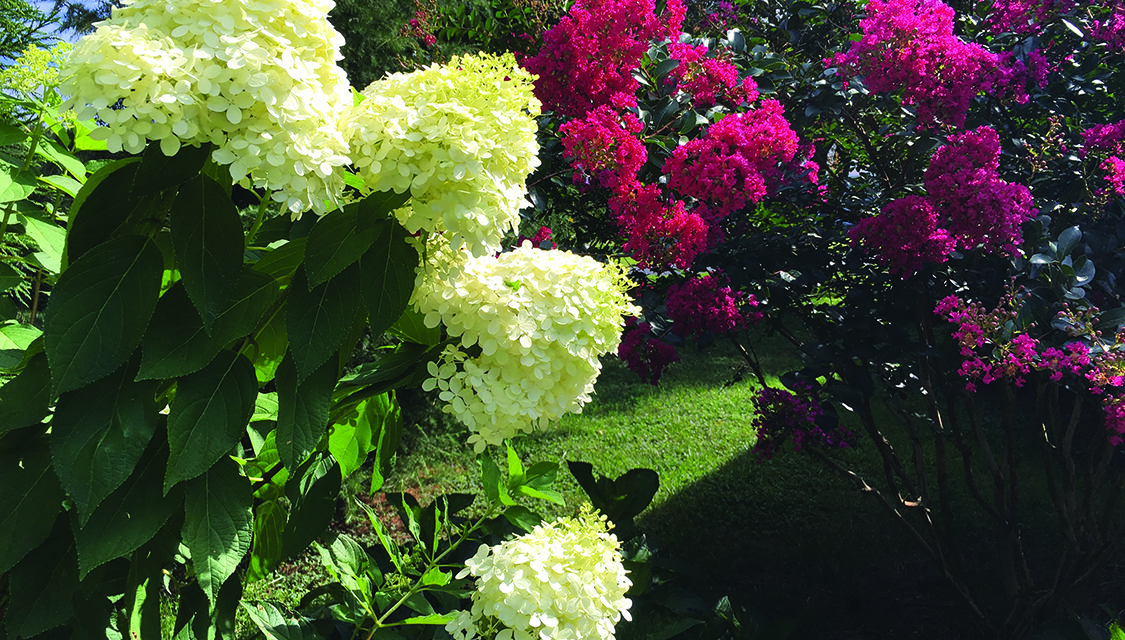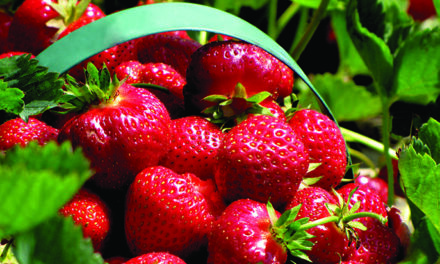
Hydrangea macrophylla “Mathilda Gutges” blooms can be blue or pink, depending on the pH of the soil. This is a mophead hydrangea. (Photos by Michele Dorsey Walfred)
Hydrangeas come in a wide variety of flowering shrubs that grow well on the Delmarva Peninsula, and some of them are native to the United States.
H. macrophylla
Perhaps the most familiar hydrangeas are the French or florist-type bigleaf hydrangeas, Hydrangea macrophylla. These bloom blue or pink, or even purple, depending on the soil pH. The blooms are blue or purple where soil is acid, pink in alkaline soil.
Unfortunately, those purchased from florists and later planted outdoors may not be winter hardy in our area and a late freeze may damage flower buds, destroying future flowers.
H. macrophylla is native to East Asia. These hydrangeas like moist soil that drains well and prefer morning sun with afternoon shade. If planted in full sun, they’ll let you know by wilting that they need a drink in the afternoon.
Older cultivars bloom on old wood, so pruning should be done just after the flowers fade. You can remove dead wood just as spring growth begins, being mindful of flower buds. Some newer varieties bloom on old and new growth. H. macrophylla will grow 6 to 10 feet tall and just as wide.
This category includes two types: mopheads and lacecaps. The mopheads have big, puffy, globe-shaped blooms and thick, shiny, heart-shaped leaves.
Lacecap blooms have flattened heads with a center of short flowers encircled by a ring of showier flowers. If you want to keep lacecaps more compact, they will tolerate removal of up to one-third of each stem when pruning.
H. serrata
Mountain hydrangea, H. serrata, is a less common but close relative of bigleaf hydrangea. Originating in the mountainous areas of Japan, they have developed better cold tolerance than mopheads. Their blooms stay dormant longer, so they are less likely to bud during a warm spell and get killed by a late freeze. Most mountain hydrangeas are lacecap flowers and their foliage is more narrow. Like their cousins, their flower color is impacted by soil pH.
Mountain hydrangeas bloom on old and new wood, so pruning should be avoided except to remove dead wood. H. serrata are typically smaller shrubs, growing 2 to 4 feet tall and 2 to 4 feet wide.
H. paniculata
Panicle hydrangeas, H. paniculata, are perhaps the most winter hardy variety. They’re also known as hardy hydrangeas or peegee hydrangeas. Native to China and Japan, they have large, cone-shaped blooms that are usually white (although some may start out chartreuse) but may turn to shades of pink in fall. H. paniculata grow 8 to 15 feet tall and can be trained to form a tree. They are easy to grow, but should have part shade in zones 7 to 9. Flowers bloom on new wood from July to September, so they can be pruned in winter, after blooms fade, or in early spring. Good drainage is a must, to avoid root rot. They can even grow in clay soil, provided it is well-drained. Do not add compost, potting mix or top soil when planting H. paniculata. This can slow drainage beyond the amended soil, leaving roots wet and susceptible to rot. In winter, H. paniculata appreciates a layer of mulch over its roots.
H. arborescens
Smooth Hydrangeas, H. arborescens, also called wild or Annabelle hydrangeas, are native to the Southeastern part of the United States. Annabelle hydrangeas were discovered more than 100 years ago in the town of Anna, Ill.
The leaves are typically heart-shaped and thin. Annabelles produce huge, symmetrical, rounded heads in June, in colors from light green to creamy white. Annabelles are often grown for cut flowers. Blossoms form on new wood, so pruning should be done in the fall or early spring. For revitalization, they can be cut back in winter to a foot high.
Newer introductions are the Incrediball and Invincibelle series, some of which are pink. Some smooth hydrangeas bear lacecap-type flowers.
H. arborescens is more cold hardy than other hydrangeas, but may die back to the ground in harsh winters. They prefer moist but well-drained, organic, acidic soil and some afternoon shade in hotter climates.
H. quercifolia
Oakleaf hydrangeas, H. quercifolia, are also native to North America. They are named for their leaves, which resemble those of red oak trees. H. quercifolia has peeling bark and fall foliage that offers a combination of orange, yellow, red, burgundy and purple.
Blooms are large and conical-shaped, opening white in June, then turning pink to dark rose. Blooms grown on old wood, so avoid pruning. If you must, do so just after they flower.
These hydrangeas can grow up to 8 feet high and 8 feet wide. If it gets too big, you can remove no more than a third of the stems after the plant flowers.
H. petiolaris
Climbing hydrangeas, H. petiolaris, or more recently known as H. anomala, are woody vines rather than shrubs. Native to Asia, they enjoy full to part-shade and grow in zones 4 to 8, although one source says it doesn’t thrive in Zone 7. I beg to differ. I’ve seen it growing 30 feet up into a tree on the banks of the Nanticoke River.
Mine has covered a lattice trellis but had in some years been damaged by a late frost or heat from a backyard grill, so it had never bloomed. Given more sun after we removed a huge tree on my property, the plant is going to bloom for the first time this year. Little pruning is necessary except to keep growth in check, as it sends runners out into the garden. Since climbing hydrangeas bloom on old wood, they should be pruned soon after the flowers fade so as not to remove next year’s buds later in the season.
Lastly, a warning: all parts of the hydrangea plant are toxic to dogs, cats, horses and humans, so they should not be ingested.
Deer, on the other hand, consider them candy and will devour them if given the opportunity.





